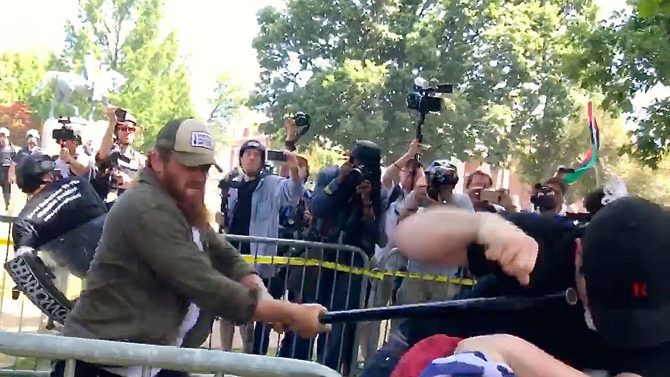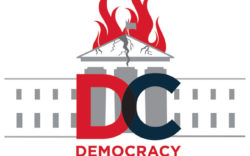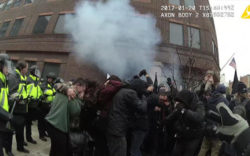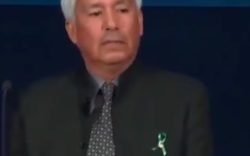Donald Trump’s press conference, in which he defended the racists in Charlottesville, VA and attacked those there to protest them, was one of the worst performances of his presidency. And it came a day after a Durham, NC statue to Confederate soldiers came down, thanks to activists who took matters into their own hands.
“So this week it’s Robert E. Lee,” Trump said Aug. 15. “I notice that Stonewall Jackson’s coming down. I wonder: Is it George Washington next week, and is it Thomas Jefferson the week after?” Trump said. “You know, you really do have to ask yourself, where does it stop?”
Early the next morning, cranes and crews of workers began removing all four of the confederate monuments in Baltimore. Here we were, a small crowd, at 4 a.m., black and white, crustpunk and square, reporter and activist, watching a statue of Confederate generals Lee and Jackson being hoisted up through the air in the surreal pre-dawn light of Baltimore and taken away. It felt like a moment of catharsis.
The mayor, Catherine Pugh, an African-American woman, is being widely praised for the order, which came after a local activist group planned an event called “Do it Like Durham.”
Sarah Willets with INDYWeek in North Carolina reported on the scene in Durham, and before the statue came down, Takiyah Thompson, one of the activists responsible for pulling it down, told her, “This land has never been ours for my people… This land has never been ours for Native Americans. This land has never been ours for queer people. This land has only been ours for rich ruling white elites, period.”
The Durham rally seemed to be winding down. Then, after someone walked up with a ladder, things went quickly, and Thompson climbed the ladder up the the plinth and wrapped a rope around the statue.
“It’s important to not just talk about, for instance, the Confederate monument being taken down as vandalism in that moment,” Bree Newsome, who broke the law to climb the pole and take down the Confederate flag on South Carolina’s capitol grounds, told Willets. “Yes, literally it’s vandalism, but if you understand the historical context and the history of that monument being erected, then you understand morally why it’s necessary for the monument to come down.”
After Dylann Roof murdered nine African Americans in Mother Emanuel Church in Charleston, SC, we should have removed the statues that are coming down now.
“It’s going to be a very exciting… as we really confront the power structure that has existed here for a very long time in ways that are full frontal,” Muhiyidin d’Baha, who later became famous when he lept across a protest line and grabbed a rebel flag from a racist hand, said to me, the day after the Mother Emanuel shooting, standing at the foot of a statue of pro-slavery South Carolina Sen. John C. Calhoun. “In ways that say, ‘This statue does not need to be here anymore.’”
The city rallied around its white mayor, who said the right words. The Calhoun monument did not come down. Activists rallied again this week for its removal. It is necessary. But Charleston, like America, is so steeped in white supremacy that we white people should not be able to feel good about the removal of a statue.
Less than 24 hours after the Durham monument takedown, Thompson, who pulled down the Confederate monument in Durham, was arrested as she left a press conference after the sheriff said, “no one is getting away with what happened.” So far, eight people have been charged—the same number of white supremacists who have been charged after Charlottesville.
I am particularly haunted by the guy pictured above. It is a still of a video I took as police were clearing out the park where the racist rally was planned. He is beating a white antifascist in the head with his long stick. Later, he was filmed and photographed beating a black man, Deandre Harris, by what looks like the Village People of racists—one with a Nazi helmet, another like a construction, one in a polo and another, like this guy, with beard and baseball hat.
He looks, hauntingly, like me—a little heftier, a slightly longer beard. How can I see him and feel good about symbolic acts? I have the quality he values most. I could have ended up like him. I grew up in Columbia, SC, where Newsome took down the rebel battle flag. I was taught, not so much at home, but in the world around me, to honor people like Robert E. Lee. And I was taught not to notice my own whiteness. Now, I can’t not notice it. After I left Charlottesville, I felt disgusted by my own skin. Whenever I saw another white person, I cringed, wondering which side they were on, and I knew people thought the same thing of me.
On Friday, it was announced that Steve Bannon was out of the Trump White House. Like the monuments coming down, I’m glad he’s out, but it’s only a small part of something so much larger. White supremacy is a white problem. Even if its grosser displays disgust us, we still benefit from it.
There were plenty of white anti-racists fighting the racists in Charlottesville and largely keeping them out of Boston. But until we fight a lot harder, we don’t get to feel good when a monument comes down.
It is not only Bannon or Trump that has a white supremacy problem. It is us.
Like what you just read? Support Flagpole by making a donation today. Every dollar you give helps fund our ongoing mission to provide Athens with quality, independent journalism.









